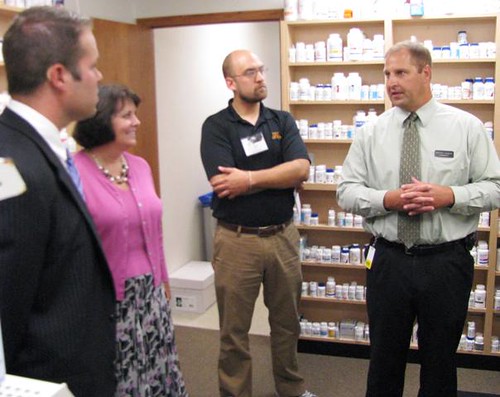
For most of its 130-year existence, the city of Adrian, Minn., has had the services of a hometown pharmacist. That is, until the local pharmacy was forced to close in 2008.
But thanks to the efforts of city officials, a partnership with Sterling Drug, and a Recovery Act grant from USDA Rural Development, Adrian was able to overcome the loss of its local pharmacy by building a telepharmacy. The telepharmacy expands the benefits of community pharmacy by connecting a satellite pharmacy in Adrian to a central support location at Sterling Drug in Worthington.
Using video, audio and data technology, a pharmacist at the central location oversees the filling and verifying of prescriptions by a technician in Adrian. Images captured at the remote location allow the pharmacist to review, approve and document all transactions.
“The telepharmacy was a unique and cost-effective way for Adrian to provide access to the services of a local pharmacy,” said Colleen Landkamer, USDA Rural Development State Director. “City officials recognized the need for a local pharmacy to remain in town and took immediate actions to make it happen.”
Rural Development helped finance the project by awarding a $99,999 Rural Business Enterprise Grant (RBEG) to Adrian. The city used the grant to create a revolving loan fund to assist local small businesses with startup, expansion and job creation projects. The telepharmacy will be one of the first local businesses to receive a loan from the RBEG funds.
The RBEG was awarded using funds from the American Recovery and Reinvestment Act, signed into law by President Obama in February of 2009.
“Sterling Drug is happy to be able to bring back pharmacy services into Adrian,” said Bryan Hagen, a pharmacist at Sterling Drug in Worthington. “The telepharmacy model is a great way to keep healthcare in smaller communities where accesses to those services are important to the communities.”
Adrian City Administrator Bruce Heitkamp says that Adrian’s population is about 35 to 40 percent seniors. Since seniors are generally less mobile than other segments of the population, they relied heavily on the hometown pharmacy to fill prescriptions and provide consultation services. Once the pharmacy closed, their only option was to travel to the next nearest location over 20 miles away.
“Our little town of Adrian just can’t afford a full-time pharmacist,” Heitkamp said. “The telepharmacy option ensures that rural areas of Minnesota can still have a hometown pharmacy.”
The telepharmacy is connected to Adrian’s government center and is only about three blocks away from the clinic. When patients leave the clinic and walk over to the telepharmacy, their prescription is usually already filled and waiting to be picked up.
“When our pharmacy closed, it was a huge blow,” Heitkamp said. “But this telepharmacy has been great so far. It’s definitely meeting the needs of the community.”



